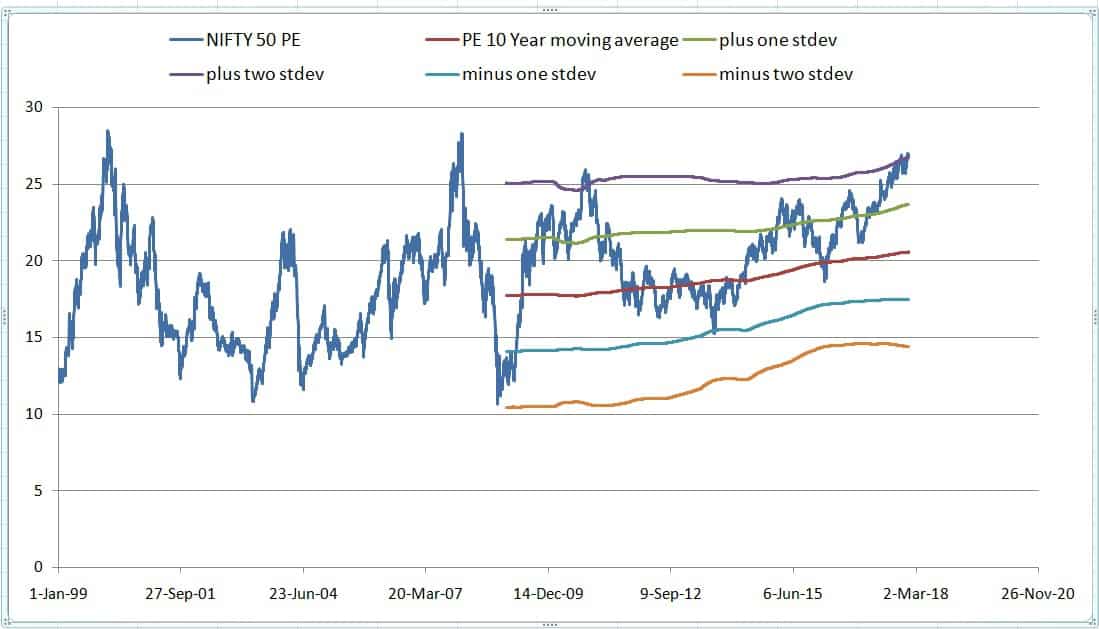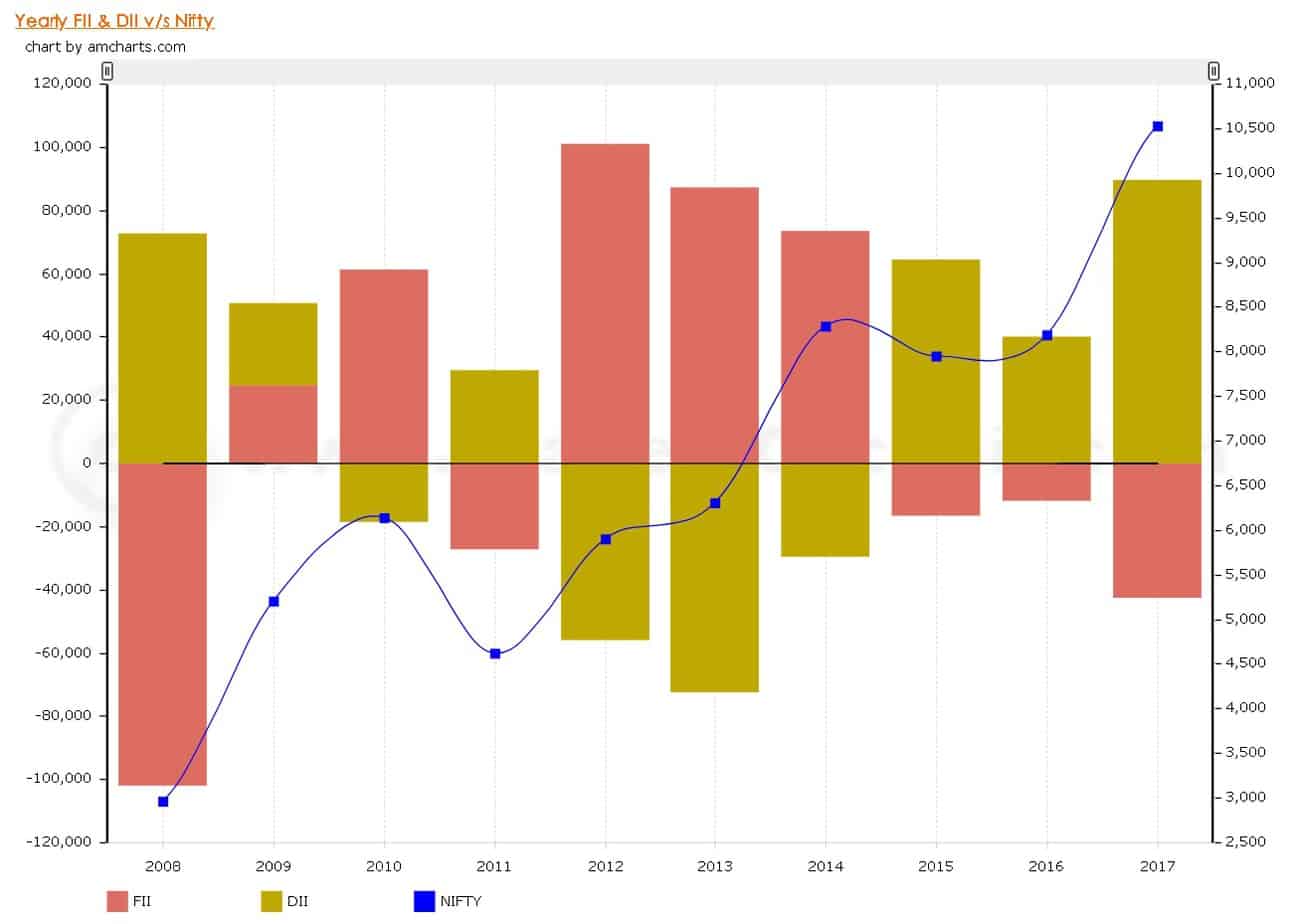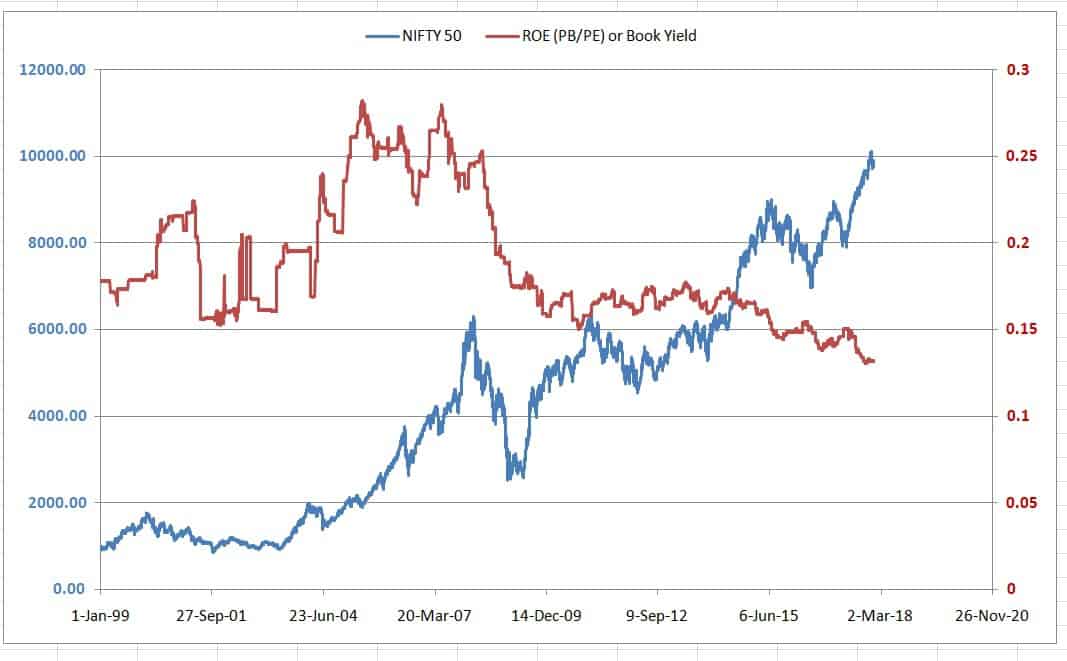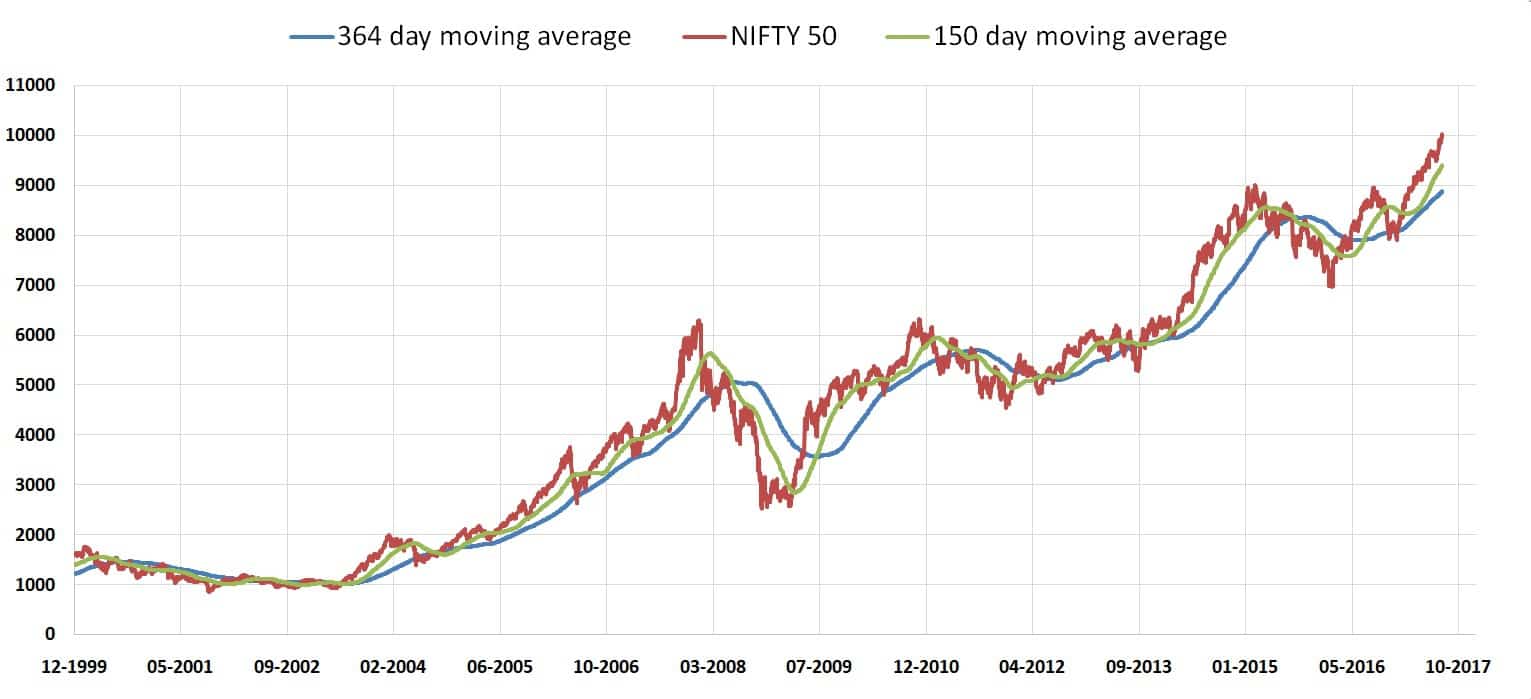Last Updated on February 20, 2022 at 9:27 pm
On 4th January 2008, the Nifty Next 50 index (then Nifty Junior) closed on 13069.35. We now know that was the end of the last great “true” bull run. On Dec 31st, 2008, the index closed at 5443.11. An incredible fall of over 58% in a year. The Sensex/Nifty peaked four days later on 8th Jan 2008, before they too fell. We are now days away from the 10th anniversary of what became the start of the 2008 housing bubble burst. Can this teach us something about risk? Let us find out.
Before we begin: Freefincal.com is among the Top 50 Indian Personal Finance Blogs And Websites For Indians and Top 60 Indian Investment Blogs And Websites For Indian Investors. Thank you, Anuj Agawaral, for the recognition.
So this is what I am referring to as the first market milestone of 2018.
Join 32,000+ readers and get free money management solutions delivered to your inbox! Subscribe to get posts via email! (Link takes you to our email sign-up form)
🔥Want to create a complete financial plan? Learn goal-based investing? Exclusive access to our DIY tools? Increase your income with your skills? Enjoy massive discounts on our robo-advisory tool & courses! 🔥
key lessons from the 2008 crash
1) As discussed earlier in What is a high index PE, when the crash occurred the Sensex PE was relatively low (based on past data then). So in real-time, many were are clueless about what was to follow. What we have is the benefit of hindsight – so easy to forget that!
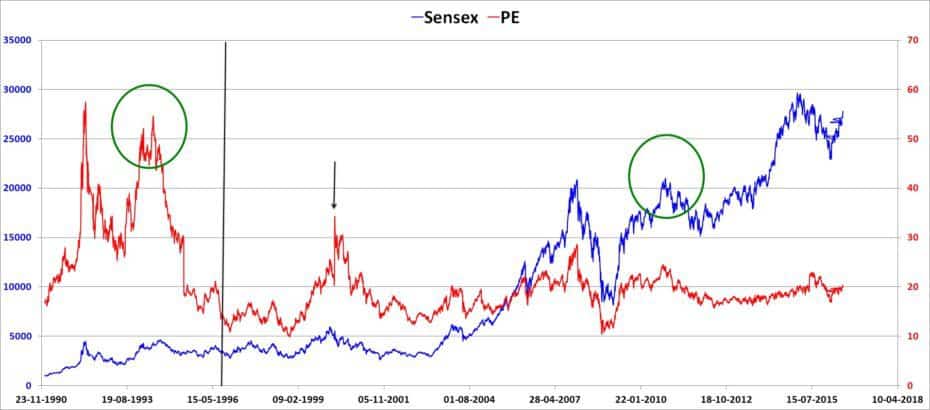
2) The concept of a “high PE” is constantly changing. Index PE fans fail to recognise this fact.
For example, this is the latest NIfty PE with 10Y PE moving average chart obtained from Nifty Valuation Analysis with PE, PB, Div Yield, ROE, EPS of 21 NSE Indices tool
Notice how the average PE and standard deviation bands are moving with each passing day. There is hardly enough proof here that PE based investing will work. Well, it does not: Misconceptions about the Nifty PE
3) The housing bubble was a lesson that markets are coupled across countries. Foreign institutional investors pulled out about one lakh crore INR in 2018 according to traderscockpit.com. The below image is from this site. The fall in Indian markets (due to their gradual pull out) started months before the fall of Lehman Brothers
And by the way, do not believe that nonsense about mutual fund SIP investors “saving” the market. If the FIIs pull out big, the market will drop and many financially literate mutual fund investors will follow suit.
Animation of the 2008 crash
Watch the Nifty Next 50 move up and crash down by 58% in 2008. Notice that as it fell, it moved up twice as though offering some hope of recovery. There is a difference between watching a snapshot of the past and an animation. The latter gives you a sense of how investors would have felt in real time. Also, recognise in 2008 we neither had smartphones nor social media penetration. The lack of information can make one scared. An excess of information can make one scared.
The last few years: Where are the corporate earnings?
Using the Nifty Valuation Analysis tool, here is the EPS 1Y rolling growth rate and the return on equity
When I see the above two graphs, I feel corporate earnings have been at least low (if not absent). Makes you wonder if the market will make us wait for earnings to catch up. How long can the market keep moving up without real growth? Then again, there are those who feel even the last bull run (2002-2008) did not result in real growth -only assets grew, jobs did not.
Have the last few years been an empty bull run based on hope? If so, how different are we from Bitcoin investors who “hodl” in the hope of long-term benefits? I wish I get answers as easily as I get questions!
The trouble is that the benefits of “good governance” will take years to manifest and within this time, governments come and go.This means, we as investors must face sequence of returns risk – that is low or negative returns for years together. That is probably the only guaranteed aspect of the market aside from daily volatility.
Can we predict market crashes with moving averages?
This seems so easy we look at past data. In an earlier post, Moving Average Market Level Indicator, I had discussed Jim Otar’s hurricane warning indicator. The idea is to plot two moving averages:
1) 5-month daily moving average (this is just the average of the daily closing values of the nifty for the last 5 months)
2) 12-month daily moving average
Bearish trend: If the 5-month DMA goes below the12-month DMA when the 12-month DMA is heading south
Bullish trend: If the 5-month DMA goes above the 12-month DMA when the 12-month DMA is heading north
Using the Nifty Valuation Analysis tool, we get this nice graph.
Now you can easily mark the bearish trends and bullish trends.
Try doing the same with this animation. Please do play this a couple of times to understand that it is not easy to predict how much the market will move up or down at any point in time.
Anyone who claims they can foresee and side-step market crashes are assuming that they can walk between raindrops without getting wet. I am not saying it is impossible to use moving averages (for long-term investing, not trading) in real-time and reduce losses. I am only saying that it is not easy and requires machine-like discipline – certainly more “discipline” than keeping a SIP running.
When we see the market fall so much in such a short time, our mind starts playing tricks. Just look at how the Bitcoin investors are behaving. They see some returns and believe everyone else, even accomplished investors, are idiots. That is the euphoria, the exhilaration showing.
The 2008 crash was a case of anti-euphoria at least for long-term investors who hit the panic button. I am not judging anyone. Who am I to do so. Who knows if 2018 is a repeat of 2008, I might be the first to exit in fear.
The purpose of writing this post is to:
(1) stop and think about what transpired ten years ago.
(2) Recognise that the fantastic equity returns could vaporise in weeks at any time
(3) There are ways to lower losses but it is one thing to assume one can and actually do so when the events unfold in real time.
Note: I have fixed the x- and y-axis scales in the two animations above with the benefit of hindsight. Let us not forget that it is not possible in reality!
Wish to a very happy 2018.
🔥Enjoy massive discounts on our courses, robo-advisory tool and exclusive investor circle! 🔥& join our community of 7000+ users!
Use our Robo-advisory Tool for a start-to-finish financial plan! ⇐ More than 2,500 investors and advisors use this!
Track your mutual funds and stock investments with this Google Sheet!
We also publish monthly equity mutual funds, debt and hybrid mutual funds, index funds and ETF screeners and momentum, low-volatility stock screeners.





- Do you have a comment about the above article? Reach out to us on Twitter: @freefincal or @pattufreefincal
- Have a question? Subscribe to our newsletter using the form below.
- Hit 'reply' to any email from us! We do not offer personalized investment advice. We can write a detailed article without mentioning your name if you have a generic question.
Join 32,000+ readers and get free money management solutions delivered to your inbox! Subscribe to get posts via email! (Link takes you to our email sign-up form)
About The Author
 Dr M. Pattabiraman(PhD) is the founder, managing editor and primary author of freefincal. He is an associate professor at the Indian Institute of Technology, Madras. He has over ten years of experience publishing news analysis, research and financial product development. Connect with him via Twitter(X), Linkedin, or YouTube. Pattabiraman has co-authored three print books: (1) You can be rich too with goal-based investing (CNBC TV18) for DIY investors. (2) Gamechanger for young earners. (3) Chinchu Gets a Superpower! for kids. He has also written seven other free e-books on various money management topics. He is a patron and co-founder of “Fee-only India,” an organisation promoting unbiased, commission-free investment advice.
Dr M. Pattabiraman(PhD) is the founder, managing editor and primary author of freefincal. He is an associate professor at the Indian Institute of Technology, Madras. He has over ten years of experience publishing news analysis, research and financial product development. Connect with him via Twitter(X), Linkedin, or YouTube. Pattabiraman has co-authored three print books: (1) You can be rich too with goal-based investing (CNBC TV18) for DIY investors. (2) Gamechanger for young earners. (3) Chinchu Gets a Superpower! for kids. He has also written seven other free e-books on various money management topics. He is a patron and co-founder of “Fee-only India,” an organisation promoting unbiased, commission-free investment advice.Our flagship course! Learn to manage your portfolio like a pro to achieve your goals regardless of market conditions! ⇐ More than 3,000 investors and advisors are part of our exclusive community! Get clarity on how to plan for your goals and achieve the necessary corpus no matter the market condition is!! Watch the first lecture for free! One-time payment! No recurring fees! Life-long access to videos! Reduce fear, uncertainty and doubt while investing! Learn how to plan for your goals before and after retirement with confidence.
Our new course! Increase your income by getting people to pay for your skills! ⇐ More than 700 salaried employees, entrepreneurs and financial advisors are part of our exclusive community! Learn how to get people to pay for your skills! Whether you are a professional or small business owner who wants more clients via online visibility or a salaried person wanting a side income or passive income, we will show you how to achieve this by showcasing your skills and building a community that trusts and pays you! (watch 1st lecture for free). One-time payment! No recurring fees! Life-long access to videos!
Our new book for kids: “Chinchu Gets a Superpower!” is now available!


Must-read book even for adults! This is something that every parent should teach their kids right from their young age. The importance of money management and decision making based on their wants and needs. Very nicely written in simple terms. - Arun.Buy the book: Chinchu gets a superpower for your child!
How to profit from content writing: Our new ebook is for those interested in getting side income via content writing. It is available at a 50% discount for Rs. 500 only!
Do you want to check if the market is overvalued or undervalued? Use our market valuation tool (it will work with any index!), or get the Tactical Buy/Sell timing tool!
We publish monthly mutual fund screeners and momentum, low-volatility stock screeners.
About freefincal & its content policy. Freefincal is a News Media Organization dedicated to providing original analysis, reports, reviews and insights on mutual funds, stocks, investing, retirement and personal finance developments. We do so without conflict of interest and bias. Follow us on Google News. Freefincal serves more than three million readers a year (5 million page views) with articles based only on factual information and detailed analysis by its authors. All statements made will be verified with credible and knowledgeable sources before publication. Freefincal does not publish paid articles, promotions, PR, satire or opinions without data. All opinions will be inferences backed by verifiable, reproducible evidence/data. Contact information: To get in touch, use this contact form. (Sponsored posts or paid collaborations will not be entertained.)
Connect with us on social media
- Twitter @freefincal
- Subscribe to our YouTube Videos
- Posts feed via Feedburner.
Our publications
You Can Be Rich Too with Goal-Based Investing
 Published by CNBC TV18, this book is meant to help you ask the right questions and seek the correct answers, and since it comes with nine online calculators, you can also create custom solutions for your lifestyle! Get it now.
Published by CNBC TV18, this book is meant to help you ask the right questions and seek the correct answers, and since it comes with nine online calculators, you can also create custom solutions for your lifestyle! Get it now.Gamechanger: Forget Startups, Join Corporate & Still Live the Rich Life You Want
 This book is meant for young earners to get their basics right from day one! It will also help you travel to exotic places at a low cost! Get it or gift it to a young earner.
This book is meant for young earners to get their basics right from day one! It will also help you travel to exotic places at a low cost! Get it or gift it to a young earner.Your Ultimate Guide to Travel
 This is an in-depth dive into vacation planning, finding cheap flights, budget accommodation, what to do when travelling, and how travelling slowly is better financially and psychologically, with links to the web pages and hand-holding at every step. Get the pdf for Rs 300 (instant download)
This is an in-depth dive into vacation planning, finding cheap flights, budget accommodation, what to do when travelling, and how travelling slowly is better financially and psychologically, with links to the web pages and hand-holding at every step. Get the pdf for Rs 300 (instant download)
